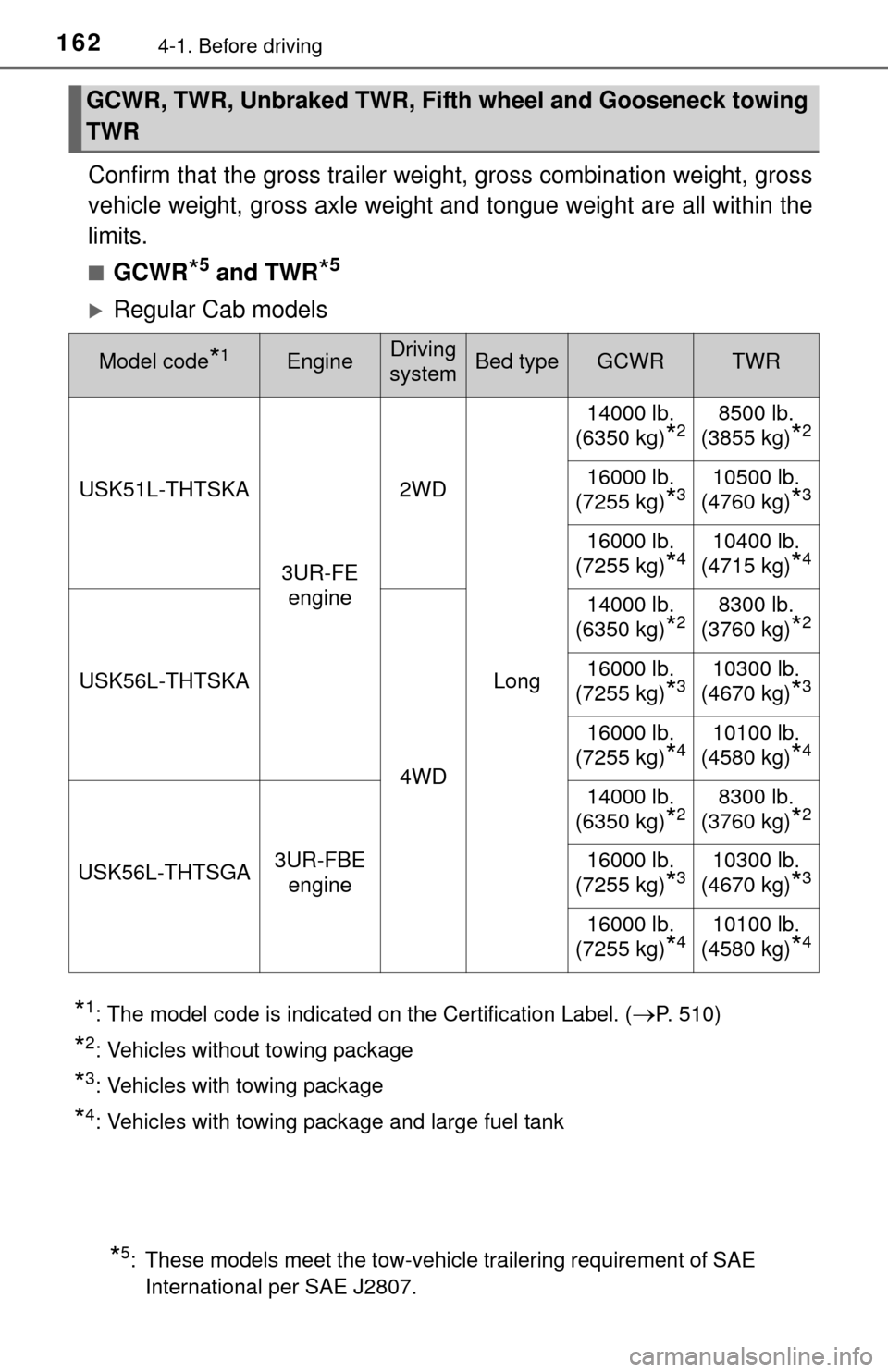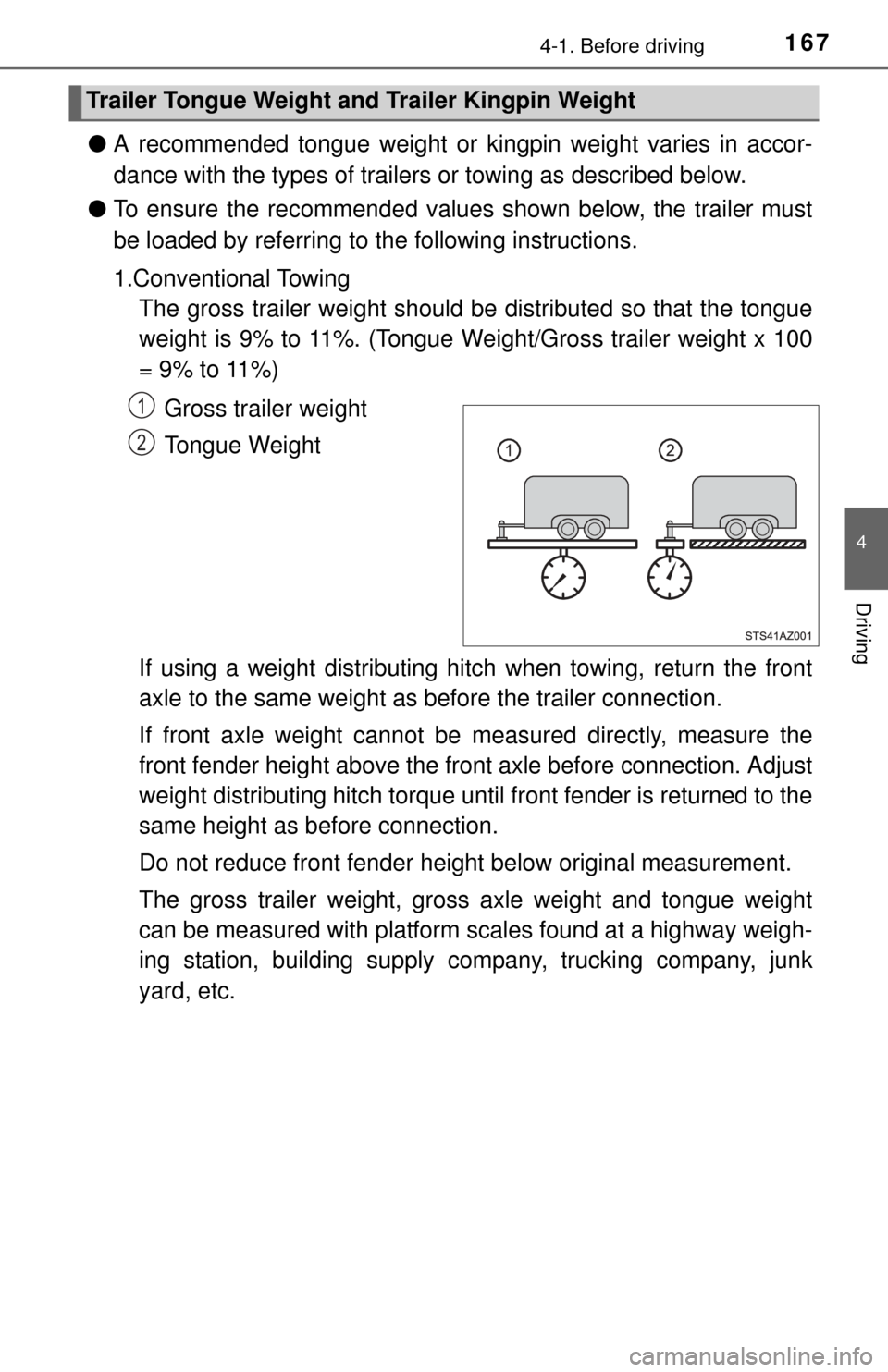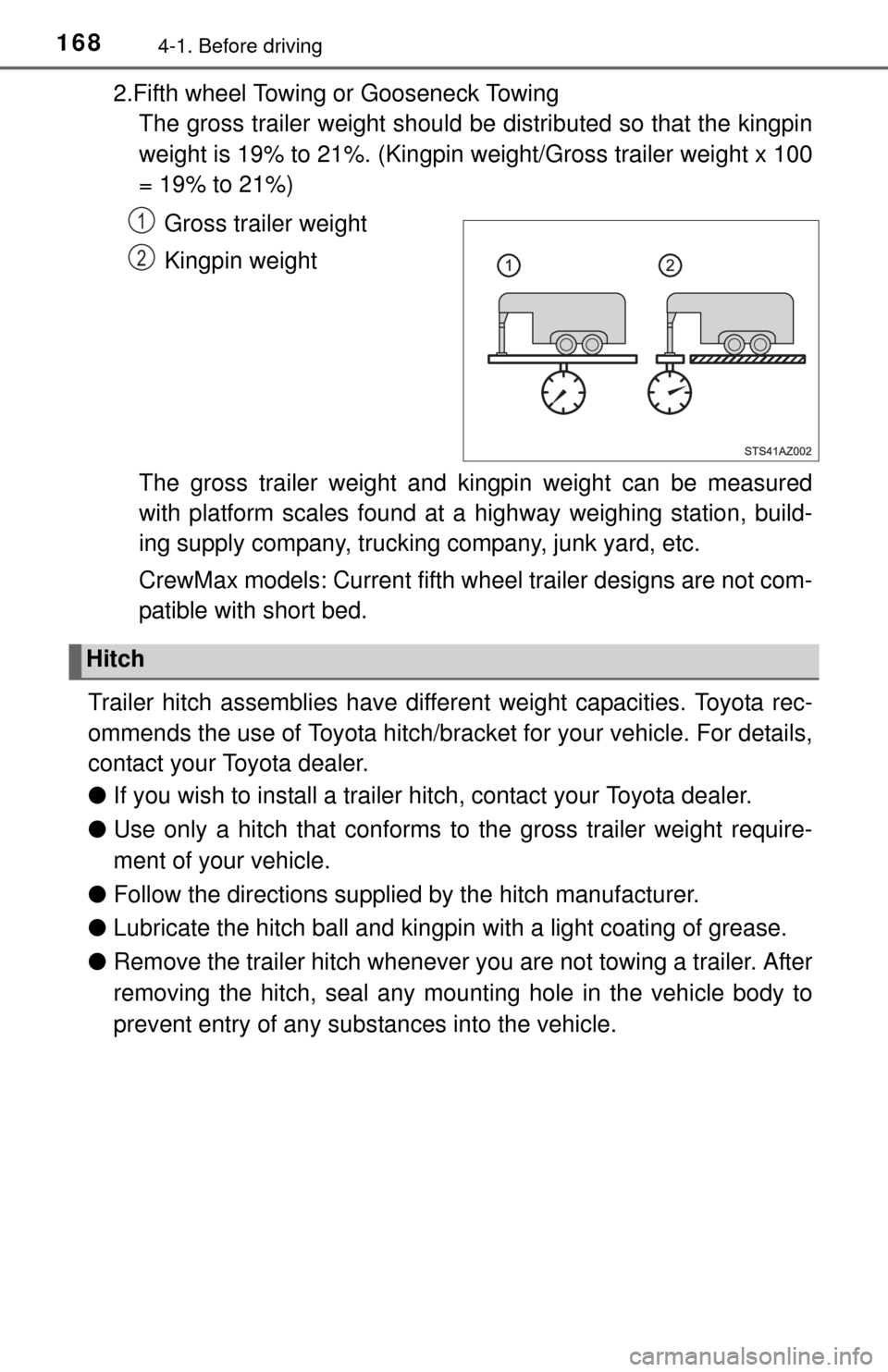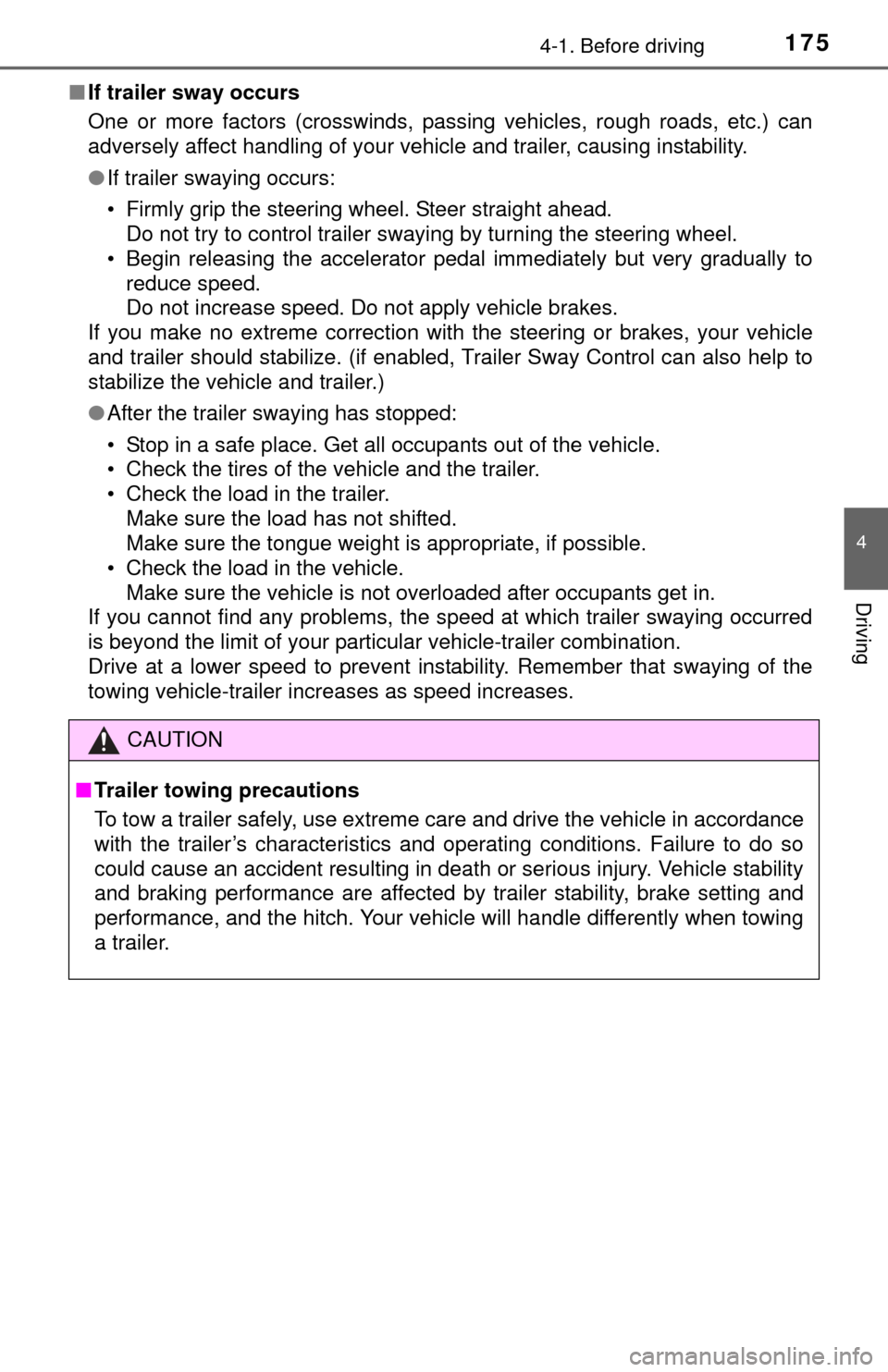Page 160 of 576
1604-1. Before driving
■TWR (Trailer Weight Rating)
The maximum allowable gross
trailer weight. The gross trailer
weight is the sum of the trailer
weight and the weight of the
cargo in the trailer.
TWR is calculated assuming
base vehicle with one driver,
one front passenger, towing
package (if available), hitch and
hitch systems (if required).
Additional optional equipment, passengers and cargo in the vehicle will
reduce the trailer weight rating so as not to exceed GCWR, GVWR and
GAWR.
If the gross trailer weight exceeds 3000 lb. (1360 kg), it is recommended
to use a trailer with 2 or more axles.
■
Unbraked TWR (Unbraked Trailer Weight Rating)
The trailer weight rating for tow-
ing a trailer without a trailer ser-
vice brake system.
■Tongue Weight
The load placed on the trailer
hitch ball. ( P. 167)
(With brakes)
(Without brakes)
Page 161 of 576
1614-1. Before driving
4
Driving
■Kingpin Weight
The load placed on the 5th
wheel mount or the gooseneck
ball. (P. 168)
● The gross trailer weight must never exceed the TWR described in
the table. ( P. 162)
● The gross combination weight must never exceed the GCWR
described in the table. ( P. 162)
● The gross vehicle weight must
never exceed the GVWR indi-
cated on the Certification Label.
● The gross axle weight on each
axle must never exceed the
GAWR indicated on the Certifi-
cation Label.
● If the gross trailer weight is over the unbraked TWR, trailer service
brakes are required.
● If the gross trailer weight is over 2000 lb. (907 kg), a sway control
device with sufficient capacity is required.
● If the gross trailer weight is over 5000 lb. (2268 kg), a weight distrib-
uting hitch with sufficient capacity is required.
Weight limits
Page 162 of 576

1624-1. Before driving
Confirm that the gross trailer weight, gross combination weight, gross
vehicle weight, gross axle weight and tongue weight are all within the
limits.
■GCWR*5 and TWR*5
Regular Cab models
*1: The model code is indicated on the Certification Label. (P. 510)
*2: Vehicles without towing package
*3: Vehicles with towing package
*4: Vehicles with towing package and large fuel tank
GCWR, TWR, Unbraked TWR, Fifth wheel and Gooseneck towing
TWR
*5: These models meet the tow-vehicle trailering requirement of SAE International per SAE J2807.
Model code*1EngineDriving
systemBed typeGCWRTWR
USK51L-THTSKA 3UR-FE engine 2WD
Long14000 lb.
(6350 kg)
*28500 lb.
(3855 kg)
*2
16000 lb.
(7255 kg)
*310500 lb.
(4760 kg)
*3
16000 lb.
(7255 kg)
*410400 lb.
(4715 kg)
*4
USK56L-THTSKA
4WD14000 lb.
(6350 kg)
*28300 lb.
(3760 kg)
*2
16000 lb.
(7255 kg)
*310300 lb.
(4670 kg)
*3
16000 lb.
(7255 kg)
*410100 lb.
(4580 kg)
*4
USK56L-THTSGA 3UR-FBE
engine 14000 lb.
(6350 kg)
*28300 lb.
(3760 kg)
*2
16000 lb.
(7255 kg)
*310300 lb.
(4670 kg)
*3
16000 lb.
(7255 kg)
*410100 lb.
(4580 kg)
*4
Page 167 of 576

1674-1. Before driving
4
Driving
●A recommended tongue weight or kingpin weight varies in accor-
dance with the types of trailers or towing as described below.
● To ensure the recommended values shown below, the trailer must
be loaded by referring to the following instructions.
1.Conventional Towing
The gross trailer weight should be distributed so that the tongue
weight is 9% to 11%. (Tongue Weight/Gross trailer weight x 100
= 9% to 11%)
Gross trailer weight
Tongue Weight
If using a weight distributing hitch when towing, return the front
axle to the same weight as before the trailer connection.
If front axle weight cannot be measured directly, measure the
front fender height above the front axle before connection. Adjust
weight distributing hitch torque until front fender is returned to the
same height as before connection.
Do not reduce front fender height below original measurement.
The gross trailer weight, gross axle weight and tongue weight
can be measured with platform scales found at a highway weigh-
ing station, building supply company, trucking company, junk
yard, etc.
Trailer Tongue Weight and Trailer Kingpin Weight
1
2
Page 168 of 576

1684-1. Before driving
2.Fifth wheel Towing or Gooseneck TowingThe gross trailer weight should be distributed so that the kingpin
weight is 19% to 21%. (Kingpin weight/Gross trailer weight x 100
= 19% to 21%)
Gross trailer weight
Kingpin weight
The gross trailer weight and kingpin weight can be measured
with platform scales found at a highway weighing station, build-
ing supply company, trucking company, junk yard, etc.
CrewMax models: Current fifth wheel trailer designs are not com-
patible with short bed.
Trailer hitch assemblies have different weight capacities. Toyota rec-
ommends the use of Toyota hitch/bracket for your vehicle. For details,
contact your Toyota dealer.
● If you wish to install a trailer hitch, contact your Toyota dealer.
● Use only a hitch that conforms to the gross trailer weight require-
ment of your vehicle.
● Follow the directions supplied by the hitch manufacturer.
● Lubricate the hitch ball and kingpin with a light coating of grease.
● Remove the trailer hitch whenever you are not towing a trailer. After
removing the hitch, seal any mounting hole in the vehicle body to
prevent entry of any subs tances into the vehicle.
1
2
Hitch
Page 169 of 576
1694-1. Before driving
4
Driving
The rear bumper of your vehicle is
equipped with a hole to install a
trailer ball. If you have any ques-
tions, contact your Toyota dealer.
The gross trailer weight (trailer
weight plus cargo weight) when
towing with the bumper must never
exceed the TWR (P. 162) or
5000 lb. (2268 kg) whichever is
lower.
Use the correct trailer ball for your application.
Trailer ball load rating
Matches or exceeds the gross
trailer weight rating of the trailer.
Ball diameter
Matches the size of the trailer cou-
pler. Most couplers are stamped
with the required trailer ball size.
Shank length
Protrudes beyond the bottom of the lock washer and nut by at least 2
threads.
Shank diameter
Matches the ball mount hole diameter size.
Bumper towing (vehicles with steel bumper only)
Selecting trailer ball
1
2
Trailer classIVII and IIII
Typical trailer ball size2 5/16 in.2 in.1 7/8 in.
3
4
Page 174 of 576

1744-1. Before driving
■Before towing
Check that the following conditions are met:
●Ensure that your vehicle’s tires are properly inflated. ( P. 517)
● Trailer tires are inflated according to the trailer manufacturer’s recommen-
dation.
● All trailer lights work as required by law.
● All lights work each time you connect them.
● The trailer ball is set at the proper height for the coupler on the trailer.
● The trailer is level when it is hitched.
Do not drive if the trailer is not level, and check for improper tongue weight,
overloading, worn suspension, or other possible causes.
● The trailer cargo is securely loaded.
● The rear view mirrors conform to all applicable federal, state/provincial or
local regulations. If they do not, install rear view mirrors appropriate for tow-
ing purposes.
● Depress TOW/HAUL button (if equipped). ( P. 184)
● The manual headlight leveling dial is correctly adjusted. (if equipped)
(P. 189)
■ Break-in schedule
If your vehicle is new or equipped with any new power train components
(such as an engine, transmission, differ ential or wheel bearing), Toyota rec-
ommends that you do not tow a trailer until the vehicle has been driven for
over 500 miles (800 km).
After the vehicle has been driven for over 500 miles (800 km), you can start
towing. However, for the next 500 miles (800 km), drive the vehicle at a speed
of less than 50 mph (80 km/h) when towing a trailer, and avoid full throttle
acceleration.
■ Maintenance
●If you tow a trailer, your vehicle will require more frequent maintenance due
to the additional load. (See “Owner’s Warranty Information Booklet” or
“Scheduled Maintenance Guide”/“Owner’s Manual Supplement”.)
● Retighten the fixing bolts of the towing ball and bracket after approximately
600 miles (1000 km) of trailer towing.
Page 175 of 576

1754-1. Before driving
4
Driving
■If trailer sway occurs
One or more factors (crosswinds, passing vehicles, rough roads, etc.) can
adversely affect handling of your vehicle and trailer, causing instability.
●If trailer swaying occurs:
• Firmly grip the steering wheel. Steer straight ahead.
Do not try to control trailer swaying by turning the steering wheel.
• Begin releasing the accelerator pedal immediately but very gradually to
reduce speed.
Do not increase speed. Do not apply vehicle brakes.
If you make no extreme correction with the steering or brakes, your vehicle
and trailer should stabilize. (if enabled, Trailer Sway Control can also help to
stabilize the vehicle and trailer.)
● After the trailer swaying has stopped:
• Stop in a safe place. Get all occupants out of the vehicle.
• Check the tires of the vehicle and the trailer.
• Check the load in the trailer.
Make sure the load has not shifted.
Make sure the tongue weight is appropriate, if possible.
• Check the load in the vehicle.
Make sure the vehicle is not overloaded after occupants get in.
If you cannot find any problems, the speed at which trailer swaying occurred
is beyond the limit of your particular vehicle-trailer combination.
Drive at a lower speed to prevent instability. Remember that swaying of the
towing vehicle-trailer increases as speed increases.
CAUTION
■ Trailer towing precautions
To tow a trailer safely, use extreme care and drive the vehicle in accordance
with the trailer’s characteristics and operating conditions. Failure to do so
could cause an accident resulting in death or serious injury. Vehicle stability
and braking performance are affected by trailer stability, brake setting and
performance, and the hitch. Your vehicle will handle differently when towing
a trailer.